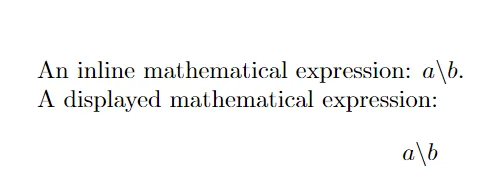How to Write a Backslash in LaTeX
In LaTeX, the backslash \ is a special character used to introduce commands. To display a backslash as a character in document, you will need to escape it by using a double backslash [\\].
The following examples show how to write a backslash in LaTeX.
How to Write a Backslash in Text
We can use a double backslash to display a backslash in LaTeX document for text.
Example: Backslash in Text
Suppose we want to write a backslash in the text.
We can use the following LaTeX code to do so:
\documentclass{article}
\begin{document}
This is an example of using a backslash \\ in a sentence.
\end{document}
Output: 👇️
This is an example of using a backslash \ in a sentence.
In this example, we use double backslash [\\] to display a single backslash in the text.
How to Write a Backslash in Mathematical Expressions
For mathematical expressions, to display backslash (), we need to escape it with another backslash: \backslash.
Example: Backslash in Mathematical Expressions
Suppose we would like to write mathematical expressions that contain a backslash.
We can use the following LaTeX code to do so:
\documentclass{article}
\begin{document}
An inline mathematical expression: \( a \backslash b \).
A displayed mathematical expression:
\[
a \backslash b
\]
\end{document}
Output: 👇️

In this example, we use the \backslash to display a single backslash in both inline and displayed mathematical expressions.
Conclusion
We can use the standard keyboard character \ for both text and mathematical expressions to display backslash. For mathematical expressions, you can use \backslash to properly render a backslash.